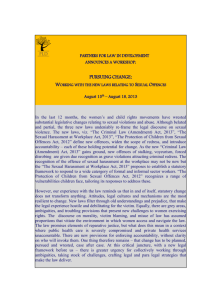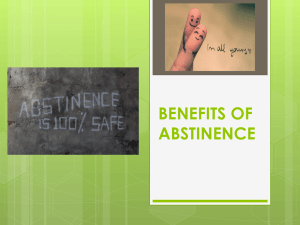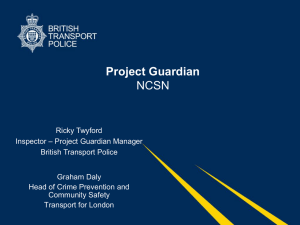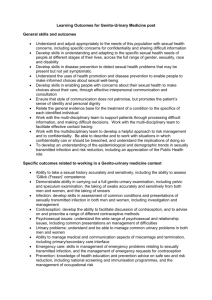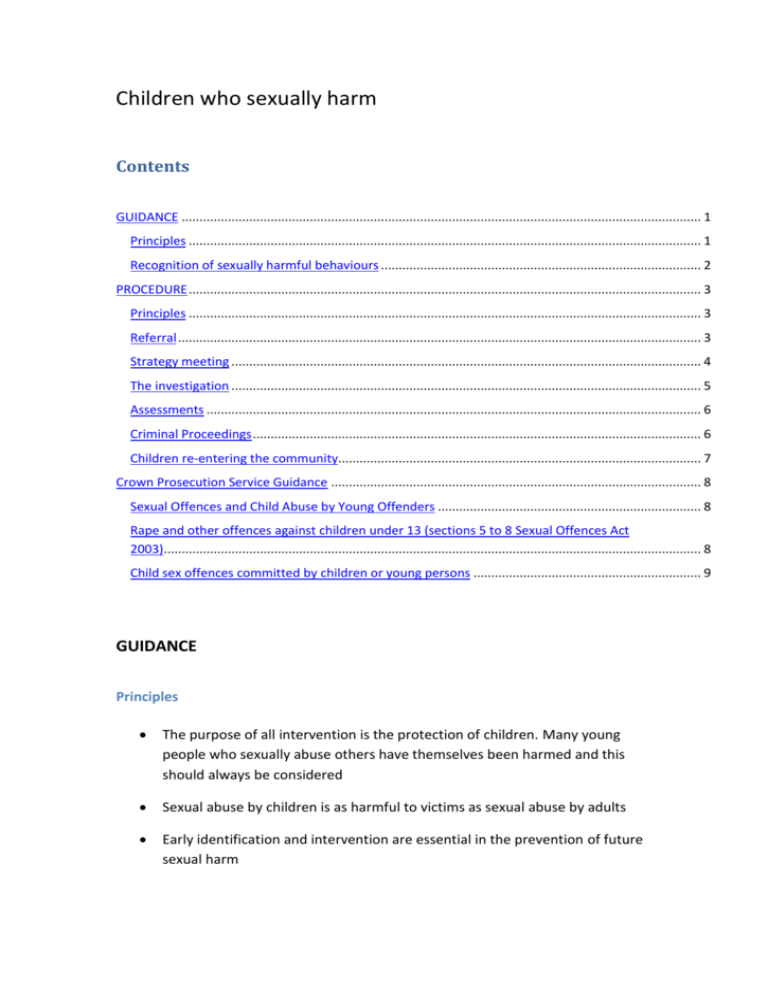
Children who sexually harm
Contents
GUIDANCE .................................................................................................................................................. 1
Principles ................................................................................................................................................ 1
Recognition of sexually harmful behaviours .......................................................................................... 2
PROCEDURE ................................................................................................................................................ 3
Principles ................................................................................................................................................ 3
Referral ................................................................................................................................................... 3
Strategy meeting .................................................................................................................................... 4
The investigation .................................................................................................................................... 5
Assessments ........................................................................................................................................... 6
Criminal Proceedings .............................................................................................................................. 6
Children re-entering the community...................................................................................................... 7
Crown Prosecution Service Guidance ........................................................................................................ 8
Sexual Offences and Child Abuse by Young Offenders .......................................................................... 8
Rape and other offences against children under 13 (sections 5 to 8 Sexual Offences Act
2003)....................................................................................................................................................... 8
Child sex offences committed by children or young persons ................................................................ 9
GUIDANCE
Principles
The purpose of all intervention is the protection of children. Many young
people who sexually abuse others have themselves been harmed and this
should always be considered
Sexual abuse by children is as harmful to victims as sexual abuse by adults
Early identification and intervention are essential in the prevention of future
sexual harm
Children who sexually harm other children should be held responsible for
their behaviour whilst also being considered to be children in need of
services.
Where possible parents/carers need to be involved in supporting children in
dealing with this behaviour
Children who sexually harm should be held accountable for their behaviour
A multi-disciplinary/agency approach is the most effective way of addressing
concerns regarding a child’s sexually harmful behaviour
Recognition of sexually harmful behaviours
All sexual contact with a child under the age of 16 is a criminal offence, irrespective
of the age of both children. However, it is recognised that children will have an
interest in sex and sexual relationships and many will engage in sexual activity (for
further information please refer to the CYSCB’s guidance on Sexually active young
people).
Defining what behaviour is appropriate and what is harmful can be difficult. Most
definitions acknowledge that abuse is bound up with concepts of consent, power
and exploitation and define sexual abuse as meaning that force or coercion has been
used upon another child to ensure participation. When considering the question of
the consent the following may be useful:
‘Consent is based on choice. Consent is active not passive. Consent is possible
only when there is equal power. Forcing someone to give in is not consent.
Going along with something because of wanting to fit in with the group is not
consent… If you can’t say ‘no’ comfortably then ‘yes’ has no meaning. If you
are unwilling to accept ‘no’ then ‘yes’ has no meaning,’ (Adams et al, 1984).
Professionals must decide in each case whether or not sexual behaviour exhibited by
the child should be categorised as abusive or not. It will be helpful to consider the
following factors:
The relative chronological and developmental age of the children (the greater
the difference the more likely the behaviour should be defined as abusive)
A differential in power or authority (relating to the age, physical or
intellectual vulnerability of the victim)
The actual behaviour (both physical and verbal factors must be considered)
Whether the behaviour could be described as age appropriate or involves
inappropriate sexual knowledge or motivation
Physical aggression, bullying, coercion, threats or bribery
The victim's experience and perception of the behaviour
Attempts to ensure secrecy
When there is concern or an allegation of a child having been sexually abused or
being likely to sexually abuse another child, a referral must be made to Children’s
Social Care’s Advice, Assessment and Early Intervention Service (AAEIS), or where
there is concern about a child’s immediate safety, the Police on 0845 6060247.
PROCEDURE
Principles
Three key principles should guide work with children who sexually harm:
there should be a coordinated multi-agency approach including youth justice
(where appropriate), children’s social care, education including educational
psychology) and health (including CAMHS) agencies and the police
the needs of children who sexually harm should be considered separately
from the needs of their victims; and
a multi-agency assessment should be carried out in each case, appreciating
that these children may have considerable unmet developmental needs, as
well as specific needs arising from their behaviour
Referral
All cases relating to a child exhibiting sexually harmful behaviour must be referred to
Children’s Social Care’s Advice, Assessment and Early Intervention Service (AAEIS).
Once received by the AAEIS, the referral must be considered, within 1 working day,
by the Referral and Assessment Team’s (R&A) Practice Manager as to whether it can
be dealt within the AAEIS or referred to the CYSCB Unit.
Cases referred to the CYSCB Unit will have elements of complexity e.g. potential
issues with interagency and cross boundary cooperation, the number of children
involved and the potential for publicity.
When deciding whether to refer the case to the CYSCB Unit the R&A Practice
Manager will consider whether the following issues can be managed without
referring to the CYSCB Unit:
The investigation
The protection and welfare needs of the victim
The protection and welfare needs of the alleged perpetrator
The potential risk posed by the alleged perpetrator towards the victim and
wider community
The potential of media interest
Where there is doubt, the R&A Practice Manager must seek advice from the CYSCB
Unit.
Strategy meeting
On receipt of a referral, a strategy meeting should take place, within 48 hours.
Agency involvement in the strategy meeting will depend on the individual
circumstances. However, all strategy meetings must include Children’s Social Care
and the Police although involvement by other relevant agencies must always be
considered.
Additional membership of the strategy meeting may include:
Schools, nursery or Further Education providers
Youth Offending Team
Health personnel
CYC Press Office
CYC legal advisor
3rd Sector organisation
Any other person who may have relevant information or expertise
Chairing of the strategy meeting is the responsibility of Children’s Social Care unless
there is involvement by the CYSCB Unit, in which case the meeting will be chaired by
a CYSCB Unit officer.
The overall purpose of a strategy meeting is to ensure a coordinated interagency
response to dealing with children who sexually harm and their victims and the free
exchange of information. The specific areas that a strategy meeting must always
ensure are:
As far a reasonably possible, that the facts are established and a judgement
made (using the balance of probability) as to whether the alleged event
occurred. This will be achieved by ensuring interagency cooperation with:
o A criminal investigation or where the police are unable to proceed
o Civil enquiries undertaken under either s47 or s17 of the Children Act
1989
The risk posed by the alleged perpetrator is assessed in relation to:
o The victim
o Any siblings or other children related children
o The community
The risk is assessed towards the alleged perpetrator in respect of:
o Being a victim of abuse
o Being a suspect
The protection and welfare needs are evaluated in respect of:
o The victim
o Alleged perpetrator
o Others
The effective management of the case including any potential media interest
Strategy meetings should always be recorded and the minutes attached to the child’s
records on the Children’s Social Care database.
The strategy meeting process must continue until such time that all actions and
recommendations are completed and until it is assessed that the risk, along with the
welfare needs of the victim and offender, can be managed without requiring further
meetings.
The investigation
Where a child is over the age of criminal responsibility and is alleged to have
committed an offence, the first interview must be undertaken by the police. Where
the child is under the age of criminal responsibility, or where they are assessed that
their intellectual capacity renders them as unable to understand the consequences
of their behaviour, the strategy meeting will decided the most appropriate course of
action in relation to any investigation.
It is the responsibility of the Police to decide whether an allegation or concern
amounts to a criminal offence. However, when deciding to prosecute a young
person, the Police and the Crown Prosecution Service should seek advice from
relevant child care professionals (see CPS guidance – appendix 1) 1
The Police must always be sensitive to the possibility that the alleged perpetrator
may also be a victim. When a child discloses that they are a victim of abuse or
neglect, this information must be immediately referred to Children’s Social Care. In
such cases a child protection conference must be convened (see CYSCB procedure
for dealing with child protection conferences).
Where it is suspected that a child’s sexually harmful behaviour has been directed or
initiated by another person, advice must always be sought by the police and CPS
from Children’s Social Care as to the potential impact of an investigation on the child
and whether a prosecution is in the child’s interest.
Where the Police and CPS decide a prosecution is not possible or where the alleged
perpetrator is found not guilty, the strategy meeting must consider what further
enquiries should be undertaken in order to establish the facts, on the balance of
probability.
Assessments
Children who are involved in the process, either as a victim or an alleged
perpetrator, should be considered as children in need and their needs assessed using
the framework for assessment by Children’s Social Care. The type of assessment
required will be dependant on the circumstances of the case.
Consideration should always be given to assessing the risk posed by the alleged
perpetrator to siblings.
The outcome of any assessment must be shared with the strategy meeting in order
to ensure any recommendations are followed.
Criminal Proceedings
Following the outcome of criminal proceedings, the Police and the YOT must inform
Children’s Social Care and the CYSCB Unit of the outcome. A decision will then be
made as to whether the strategy meeting should be reconvened.
Where a child is convicted of a sexual offence, there may be a requirement for
registration on the sex offender’s register. In these circumstances, the YOT report,
‘Although a reprimand or final warning may provide an acceptable alternative in some cases,
in reaching any decision, the police and the CPS will have to take into account fully the view of
other agencies involved in the case, in particular the Social Services. The consequences for the
victim of the decision whether or not to prosecute, and any views expressed by the victim or the
victims family should also be taken into account’. (CPS 2010)
1
strategy meeting minutes and any Children’s Social Care assessment and
recommendations will be considered at the MAPPA.
Children re-entering the community
Children who are re-entering the community following a custodial sentence or time
in secure accommodation due to sexually harmful behaviours must also be referred
to the AAEIS and require a multi-agency response.
Where a child has been convicted of a sexual offence, the MAPPA must be invoked.
Where a child has been released from secure accommodation a strategy meeting
should be held which should follow the same considerations outlined in the section
strategy meetings.
Crown Prosecution Service Guidance
Sexual Offences and Child Abuse by Young Offenders
This guidance expands on, and should be read in conjunction with other specific
sections elsewhere in Legal Guidance, such as Sexual Offences. Also note the
Notification requirements. Any decision to prosecute or not to prosecute should be
free of discrimination on the grounds of sexual orientation and gender.
If an allegation of any sexual abuse committed by a youth offender has been fully
investigated and there is sufficient evidence to justify instituting proceedings, the
balance of the public interest must always be carefully considered before any
prosecution is commenced. Positive action may need to be taken at an early stage of
offending of this type. Although a reprimand or final warning may provide an
acceptable alternative in some cases, in reaching any decision, the police and the
CPS will have to take into account fully the view of other agencies involved in the
case, in particular the Social Services. The consequences for the victim of the
decision whether or not to prosecute, and any views expressed by the victim or the
victims family should also be taken into account.
In child abuse cases, it will be important to have the views of the Social Services on
file if at all possible, as well as any background or history of similar conduct,
information about the relationship between the two and the effect a prosecution
might have on the victim.
Any case referred to the CPS for advice, or in which a prosecution does proceed,
must be dealt with as quickly as possible to minimise the delay before the case
comes to court.
Irrespective of whether the evidence is sufficient to found a criminal prosecution,
The Social Services will consider taking civil action, such as care proceedings, to
protect the child. The police and the CPS may well be asked to disclose evidence to
assist in this process. Great care should be taken to follow the guidance set out in
the section on disclosure to third parties
Rape and other offences against children under 13 (sections 5 to 8 Sexual Offences
Act 2003)
A mistaken belief that the child under 13 was 16 or over and consented to
intercourse is not a defence to an allegation of rape of a child under 13, assault of a
child under 13 by penetration, sexual assault of a child under 13 or causing or
inciting a child under 13 to engage in sexual activity contrary to Sections 5 to 8
Sexual Offences Act 2003 respectively.
When reviewing a case, in which a youth under 18 is alleged to have committed an
offence contrary to sections 5 to 8, careful regard should be paid to the following
factors:
the relative ages of both parties;
the existence of and nature of any relationship;
the sexual and emotional maturity of both parties and any emotional or
physical effects as a result of the conduct;
whether the child under 13 in fact freely consented (even though in law this
is not a defence) or a genuine mistake as to her age was in fact made;
whether any element of seduction, breach of any duty of responsibility to
the girl or other exploitation is disclosed by the evidence.
If the sexual act or activity was in fact genuinely consensual and the youth and the
child under 13 concerned are fairly close in age and development, a prosecution
contrary to sections 5 to 8 is unlikely to be appropriate. Action falling short of
prosecution may be appropriate. In such cases, the parents and/or welfare agencies
may be able to deal with the situation informally.
However, if a very young child has been seduced by a youth, or a baby-sitter in a
position of responsibility has taken advantage of a child under 13 in his/her care;
prosecution is likely to be in the public interest. Where a child under 13 has not
given ostensible consent to the activity, then a prosecution contrary to sections 5 to
8 is likely to be the appropriate course of action.
It will be important to have the views of the Social Services on file if at all possible, as
well as any background or history of similar conduct, information about the
relationship between the two and the effect a prosecution might have on the victim.
Rape of a child under 13 (section 5), assault of a child under 13 by penetration
(section 6) and causing or inciting a child under 13 to engage in sexual activity that
involves penetration (section 8) are indictable only offences with a maximum
sentence of life imprisonment. The offences of sexual assault of a child under 13
(section 7), causing or inciting a child under 13 to engage in sexual activity where
there has been no penetration (section 8) are punishable on indictment with
imprisonment for a term not exceeding 14 years. They are all grave crimes for the
purposes of section 24 Magistrates Courts Act 1980 and s.91 Powers of Criminal
Courts (Sentencing) Act 2000.
Child sex offences committed by children or young persons
Section 13 of the 2003 Act makes it an offence for a youth under 18 to have sexual
activity with a child under 16, cause or incite a child under 16 to engage in sexual
activity, engage in sexual activity in the presence of a child under or cause a child
under 16 to watch a sexual act. These offences are punishable on indictment with
imprisonment for a term not exceeding 5 years. They are grave crimes for the
purposes of section 24 Magistrates Courts Act 1980 and section 91 Powers of
Criminal Courts (Sentencing) Act 2000. Section 13 (2) (a) purports to restrict the
maximum penalty on summary conviction to a maximum of 6 months imprisonment,
although this should be read in the light of section 101 (2) Powers of Criminal Courts
(Sentencing) Act 2000 to allow a Detention and Training Order of up to 24 months.
An offence is not committed if the child is over 13 but is under 16 and the youth has
a reasonable belief that the child is 16 or over.
It should be noted that where both parties to sexual activity are under 16, then they
may both have committed a criminal offence. However, the overriding purpose of
the legislation is to protect children and it was not Parliaments intention to punish
children unnecessarily or for the criminal law to intervene where it was wholly in
appropriate. Consensual sexual activity between, for example, a 14 or 15 year-old
and a teenage partner would not normally require criminal proceedings in the
absence of aggravating features. The relevant considerations include:
the respective ages of the parties;
the existence and nature of any relationship
their level of maturity;
whether any duty of care existed;
whether there was a serious element of exploitation.


